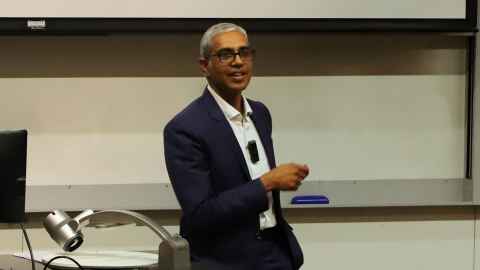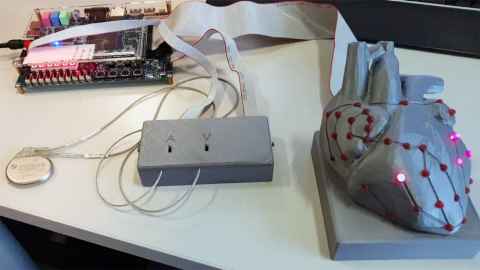Lockdown inspires new research on pandemic control
19 May 2020
Professor Partha Roop and his colleagues are currently pursuing “a truly engineering perspective” to the ongoing pandemic.

Like it has for many others working from home, COVID-19 left Professor Partha Roop from the Department of Electrical, Computer, and Software Engineering with feelings of despondency and helplessness. Fortunately, this quickly sparked a research prompt.
The country was merely a few days into its strict Level 4 lockdown when he “just woke up with the idea that pandemic control is actually akin to a control systems problem.”
At its core, the theory is used by engineers to describe control dynamics in physical processes and includes two components: the ‘plant’ and their ‘controller’. Dr Roop suggests adaptive cruise control in vehicles as an everyday example: as a controller; it “maintains a continuous feedback loop” by sensing values such as a top speed, and outputs control actions, irrespective of a road’s incline or wind speed. It can automatically adjust the value of a throttle to keep a vehicle’s speed at a set point.
His recent research in control systems theory has been on safety-critical medical devices. In his field, devices such as pacemakers are used to provide therapy for cardiac arrhythmia such as bradycardia. They are viewed as ‘controllers’ which monitor and respond to the electrical conduction in the heart – a physical model – as a ‘plant’. These parts with physical and computational elements are cyber-physical systems (CPS), and they are everywhere: mechanics, biology, nature and more.

Most importantly, it led to his realisation that this ubiquitous theory may be applied to epidemiology. For Dr Roop, our government’s actions should be modelled as the ‘controller’ in our pandemic response system. Its goal is to keep the parameter R₀ – that is, the oft-mentioned reproduction number indicating how many infected people can be traced from a single source – to a value under 1, by flattening the curve to prevent exponential growth of COVID-19.
New Zealand is unique in its availability of COVID-19 data. This includes the non-pharmaceutical interventions (NPIs) that align with our government’s four-level alert system: closing non-essential businesses, domestic travel restrictions, hygiene requirements, and more. His team found reports with values assigned to each NPI. His team found reports with values assigned to each NPI in relation to their effect to R₀.
To test his theory, Partha’s team was able to calculate the impacts on our country – by computing the number of cases using control systems theory– as NPIs change according to the alert system. With the openly-sourced data, they are able to redesign their controllers accordingly so as to study the impact of imposing or lifting certain restrictions at a certain point in time.
There was room to experiment with a variety of examples, both well-managed and poorly-used control strategies. One test indicated that a 120-day Level 4 lockdown may eliminate the disease from Aotearoa albeit with negative impacts on our economy. Some other tests utilised the indecisive control actions of the UK and Italy, which would have led to catastrophic consequences: over 29,000 deaths in New Zealand.
A controller that mimicked our real life four-level gradual lockdown showed that businesses can resume trading by early June, though some other NPIs should remain in place. This validates Aotearoa’s current strategy. “The beauty of this is that we haven’t consulted our government, but can prove how they’ve been successful. Our contribution is in formalising policies with mathematics.” In the near future, he intends to extend the approach to optimise for both R₀ and to ensure minimal economic impact.
We managed to track the dynamics of a real pandemic. This is a truly engineering perspective to COVID-19.
They have submitted their results as a paper currently under peer review, though Dr Roop already sees possibilities for how the research can evolve. The research community has responded positively, with experts from other institutions showing interest in applying Control Engineering to the ongoing responses where COVID-19 is still rapidly evolving. This includes researchers from the Indian Institute of Technology in Jammu and Bombay consulting his team to collaborate, study and share information on pandemic control in our countries.
The modelling software they’ve put together is made available on GitHub, which utilises a programming language previously developed in-house by one of the co-authors for their PhD, Nathan Allen, called Hybrid Automata Modelling Language (or more simply, HAML, pronounced like the lead actor in Star Wars).
The team sees HAML as relevant for pandemic modelling and control, and its singular, compositional system as a strength. The code’s inputs and outputs – or controller and plant variables – are clearly defined to the user, who can add their own additional constraints, including non-deterministic inputs to model human behaviour. Because its parameters can be customised and scaled, it’s potentially useful in contexts beyond their model of a broad, nationwide overview – this flexibility allows different planning and scenario analyses. Organisations such as the University, or even our faculty may benefit from this.
One of Dr Roop’s major visions is to create a custom tool; a web-based application accessible to anyone “even with very little knowledge of mathematics”.
We’ve seen with Jacinda Ardern, Dr Ashley Bloomfield and their team that our success depended on making the right decisions based on complex information from scientists. What if every decision-maker had access to similar knowledge and tools, and can mimic different scenarios in serious cases like this?
Working in a new domain like this is challenging, but Dr Roop has seen an outpouring of researchers providing their perspectives and expertise. It has encouraged interdisciplinary collaboration from people of different stages of their academic careers, all approaching the situation altruistically. His collaborators and co-authors include Dr Jin Woo Ro, Nathan Allen, and Dr Weiwei Ai – all post-doctoral researchers from his department – working alongside Debi Prasad, a senior lecturer and hepatologist from the Faculty of Medical Health Sciences. “This is by no means my work alone. Everyone’s doing this pro-bono, on top of their usual workload.”
Dr Roop recognises these results as a silver lining to our current situation, even if it involved some months’ worth of time and resources. He felt more confident that they were on the right track when experts worldwide – including control systems researchers at the University of British Columbia – began to publish similar work – “they’re solving the problems differently, but they have similar ideas”. Novel research avenues are being explored. Prasad coined their approach as ‘compositional cyber-physical epidemiology’.
“My wife is constantly saying, ‘you don’t know anything about pandemics’, so I sometimes regret doing this”, he jokes.
“My actual response is that engineers solve problems, and this is a real problem. I feel like I’m locked down at home and not contributing in any way, so let’s see if I can do something. And like many other times, we fail, but if we do, that’s okay. The point is, if you tie our hands – just like this pandemic has – we will free ourselves to do something about it.”